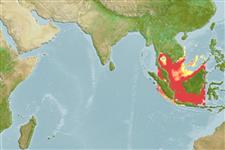>
Clupeiformes (Herrings) >
Engraulidae (Anchovies) > Coiliinae
Etymology: Setipinna: Latin, septem = seven + Latin, pinna, -ae = fin.
More on author: Bleeker.
Environment: milieu / climate zone / depth range / distribution range
Ekologi
laut; air tawar; payau. Tropical; 19°N - 8°S, 99°E - 118°E (Ref. 189)
Western Central Pacific: Thailand south to Java, including rivers, e.g., the Chao Praya in Thailand and the Rokan, Kapuas and Barito in Indonesia and the Mekong River system.
Size / Weight / umur
Maturity: Lm ? range ? - ? cm
Max length : 33.0 cm SL jantan/; (Ref. 30857); common length : 19.0 cm SL jantan/; (Ref. 9822)
deskripsi pendek
Morfologi | Morfometrik
Duri punggung (Keseluruhan (total)): 0; Duri dubur 0; Sirip dubur lunak: 45 - 53. Belly with 21 to 26 + 8 to 10 = 30 to 35 keeled scutes from isthmus to anus. Lower gill rakers with serrae rather large, spiky, but not distinctly clumped. Pectoral filament short or even absent, never reaching even to anus. Gill cover and main part of pectoral fin often dusky or jet black; other fins pale to bright yellow (Ref. 189). Origin of anal fin in front of origin of the dorsal fin (Ref. 43281).
This species was recorded up rivers at 90, 150 and 210 km from the sea, but it is not known if these are permanent freshwater populations or migrants from the sea. At least small numbers enter artisanal river and lake fisheries (Ref. 9822). Found in large rivers far upstream from the estuary (Ref. 12693). Feeds mainly on insect larvae and small fishes. Used to make prahoc (Ref. 12693).
Life cycle and mating behavior
Kematangan | Reproduksi, perkembang biakan | Pemijahan | telur-telur | Fecundity | Larva
Wongratana, T., T.A. Munroe and M. Nizinski, 1999. Order Clupeiformes. Engraulidae. Anchovies. p. 1698-1753. In K.E. Carpenter and V.H. Niem (eds.) FAO species identification guide for fishery purposes. The living marine resources of the WCP. Vol. 3. Batoid fishes, chimaeras and bony fishes part 1 (Elopidae to Linophrynidae). FAO, Rome. (Ref. 9822)
Status IUCN Red List (Ref. 130435)
ancaman kepada manusia
Harmless
penggunaan manusia
Perikanan: perikanan swasembada
informasi lanjut
Nama-nama umumSinonim (persamaan)metabolismePemangsaEkotoksikologiReproduksi, perkembang biakanKematanganPemijahanSpawning aggregationFecunditytelur-telurpekembangan telor
AcuanBudidaya airprofil budidaya airStrainGenetikaElectrophoresesDiturunkanPenyakit-penyakitPengolahanNutrientsMass conversion
mitraGambarStamps, Coins Misc.Suara-suaraCiguateraKecepatanTipe renangArea insangOtolithsOtakPenglihatan / visi
Alat, peralatan
laporan khas
muat turun XML
Sumber internet
Estimates based on models
Preferred temperature (Ref.
123201): 24.1 - 28.6, mean 28 °C (based on 430 cells).
Phylogenetic diversity index (Ref.
82804): PD
50 = 0.5039 [Uniqueness, from 0.5 = low to 2.0 = high].
Bayesian length-weight: a=0.00525 (0.00303 - 0.00910), b=3.03 (2.88 - 3.18), in cm total length, based on LWR estimates for this species & (Sub)family-body (Ref.
93245).
Trophic level (Ref.
69278): 3.9 ±0.63 se; based on food items.
Daya lenting (Ref.
120179): sedang, Waktu penggandaan populasi minimum 1.4 - 4.4 tahun (Preliminary K or Fecundity.).
Fishing Vulnerability (Ref.
59153): Low to moderate vulnerability (30 of 100).
